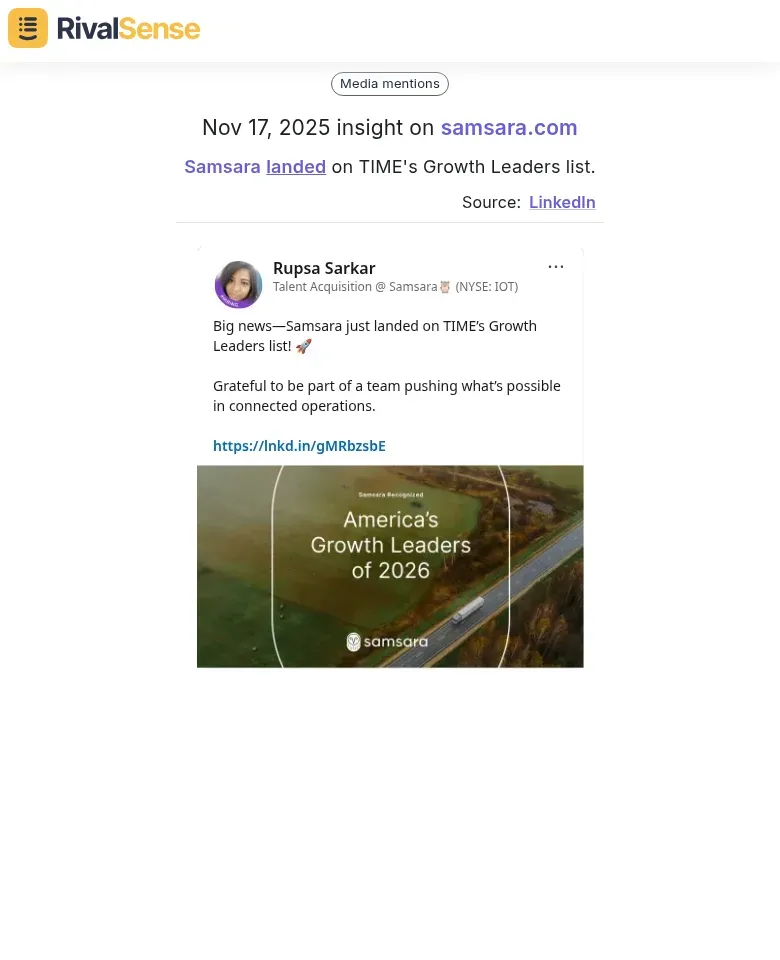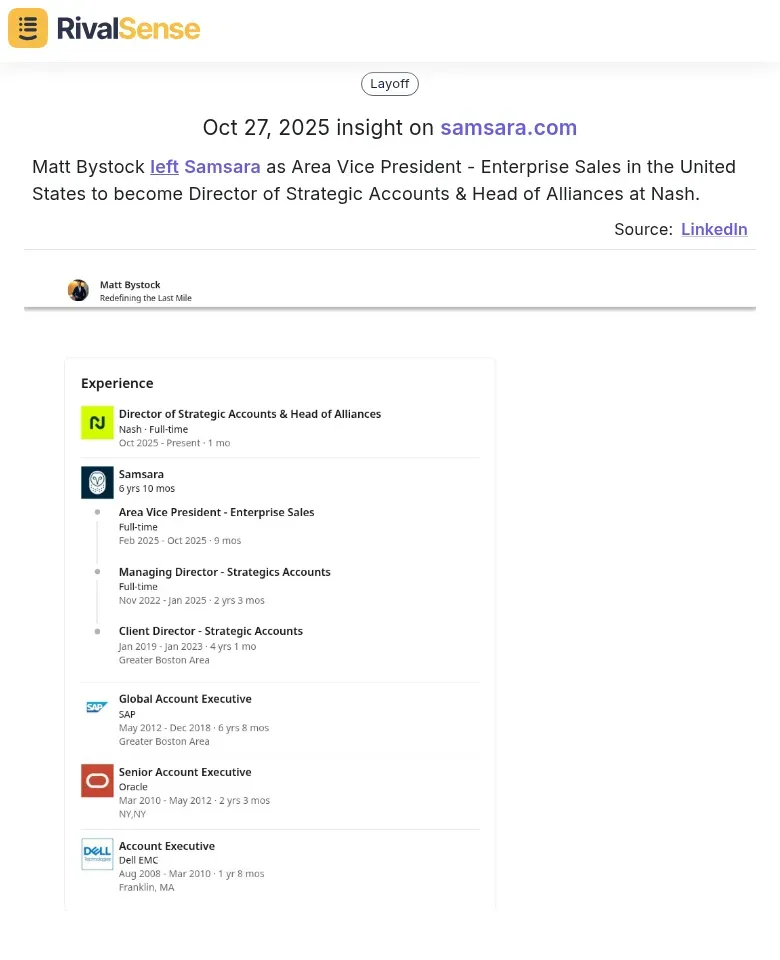Advanced Key Account Tracking Tactics for IoT Operations Leaders
Key account tracking is the systematic monitoring of your most valuable customers' activities, needs, and competitive landscape. For IoT operations leaders, this is critical because IoT deployments involve long-term partnerships, complex integrations, and recurring revenue streams. Competitor insights drive strategic advantage by revealing gaps in your offerings, emerging threats, and opportunities for differentiation. For example, if a competitor launches a new IoT security feature that your key accounts are adopting, you can proactively address this to retain clients.
To leverage external signals in account management:
- Monitor competitors' press releases, case studies, and social media for mentions of your key accounts
- Track industry forums and review sites for client feedback on competitors
- Use tools like RivalSense to automate tracking and receive alerts
- Create a checklist for regular reviews:
- ✅ Weekly review of competitor activities
- ✅ Quarterly deep-dive on account sentiment
- ✅ Annual competitive positioning analysis
💡 Practical tip: Set up Google Alerts for your top 5 competitors and key accounts to stay informed without manual effort.
Leveraging Industry Recognition for Competitive Positioning
Industry awards and rankings offer more than just prestige—they're powerful competitive intelligence tools for IoT operations leaders. Use these recognition programs to identify emerging market trends and validate your strategic direction. When competitors win awards for specific IoT applications or technologies, it signals market validation and helps you spot growth opportunities.
For instance, RivalSense tracked that Samsara landed on TIME's Growth Leaders list. This type of insight is valuable because it highlights market validation and can help you benchmark your own growth against competitors, informing your positioning and strategy.

Practical steps for leveraging recognition:
- Create a competitor awards tracker: Monitor key competitors' industry accolades quarterly
- Analyze award criteria: Understand what judges value to align your own initiatives
- Benchmark performance gaps: Compare your recognition against competitors to set measurable goals
- Incorporate into key account messaging: Use validated achievements in sales conversations and proposals
- Differentiate with third-party validation: Highlight awards that demonstrate unique capabilities
📊 Example: If a competitor wins "Best Industrial IoT Platform," analyze their features, pricing, and customer success stories to refine your positioning.
Tracking Leadership Movements for Strategic Insights
Tracking leadership movements provides critical strategic insights for IoT operations leaders. Monitor executive transitions at key competitors to anticipate shifts in focus, alliances, and market priorities. When a CTO moves to a new IoT platform company, it signals emerging opportunities in that technology space. Similarly, sales leadership changes can reveal new account targeting strategies.
RivalSense identified that Matt Bystock left Samsara as Area Vice President - Enterprise Sales in the United States to become Director of Strategic Accounts & Head of Alliances at Nash. Insights like this are valuable because they can reveal shifts in competitor strategies, potential alliances, or new market focuses, allowing you to adjust your account targeting accordingly.

Practical steps:
- Set up alerts for C-suite and VP-level changes at top 5-10 competitors
- Track movements between competitors and potential partners to identify alliance shifts
- Analyze new executive backgrounds to predict technology or market focus changes
- Map leadership changes to account targeting—adjust engagement strategies when key decision makers move
- Use personnel intelligence to identify underserved markets or emerging IoT applications
🚀 Actionable hint: When a competitor's IoT operations VP joins a smart city startup, it may indicate growing focus on municipal contracts—preempt their market entry by adjusting your targeting.
Utilizing Certifications to Enhance Trust and Compliance
Certifications like ISO 27001 for information security and ISO 9001 for quality management are powerful tools for IoT operations leaders to build trust and ensure compliance. Address customer security concerns by prominently showcasing these certifications in proposals and marketing materials—this signals a commitment to robust data protection and operational excellence. Use compliance milestones, such as achieving SOC 2 or GDPR alignment, to position your offerings as reliable and forward-thinking, highlighting how they meet evolving regulatory demands.
RivalSense reported that Samsara earned ISO 42001 certification for the safe and responsible use of AI on October 21. Certification insights are valuable because they demonstrate a competitor's commitment to standards, helping you identify areas for improvement in your own compliance and trust-building efforts.

Integrate certification insights into your strategy:
- Conduct regular audits and gap analyses to identify vulnerabilities
- Map certifications to specific client pain points—e.g., ISO 27001 can alleviate fears about data breaches in IoT deployments
- Create a certification roadmap with timelines and train teams on compliance requirements
📋 Checklist for certifications:
- ✅ Audit current certifications
- ✅ Identify gaps in compliance
- ✅ Update documentation regularly
- ✅ Communicate achievements to stakeholders
Integrating Insights into Proactive Account Strategies
Advanced key account tracking requires integrating diverse competitor signals—from pricing changes and product launches to executive moves and customer reviews—into a unified dashboard. IoT operations leaders should combine these insights with market trends and customer feedback to create holistic account plans. For example, if a competitor announces a new IoT sensor, analyze its impact on your key accounts and adjust your value proposition accordingly.
Develop proactive tactics by anticipating competitor moves:
- Use scenario planning: If Competitor X lowers prices, prepare a bundled offering; if they launch a feature, highlight your superior security or integration
- Seize opportunities by identifying gaps in their coverage or service issues reported by shared clients
Implement continuous monitoring with:
- Automated alerts for competitor activities
- Scheduled strategy reviews quarterly
- Feedback loop from sales teams
📈 Checklist for integration:
- ✅ Aggregate signals daily
- ✅ Update account plans bi-weekly
- ✅ Conduct war games for response drills
Conclusion: Driving IoT Success with Intelligent Tracking
Advanced key account tracking in IoT demands a strategic approach that combines real-time monitoring with competitor intelligence. By implementing structured tracking practices—such as automated alerts for competitor product launches, pricing changes, and customer reviews—IoT leaders can anticipate market shifts and protect key accounts. Emphasize competitor intelligence as a cornerstone for long-term growth; it uncovers gaps in your offerings and informs proactive account defense.
Practical steps to start:
- Set up a dashboard to track competitor IoT deployments and service updates
- Use AI tools to analyze competitor social media and support channels for emerging trends
- Conduct quarterly SWOT analyses on top rivals to identify vulnerabilities
- Adopt a pilot tracking program on 2-3 key accounts to refine your approach before scaling
🔥 Ready to elevate your key account tracking? Try RivalSense for free at https://rivalsense.co/ and get your first competitor report today to stay ahead in the dynamic IoT landscape!
📚 Read more
👉 Leverage Media Mentions for Competitive Content Strategy Wins
👉 Leveraging Competitor Insights for Strategic Advantage
👉 Competitor Product Update Analysis: Your Practical Guide to Staying Ahead
👉 Mastering Real-Time Competitor Alerts in Cloud Infrastructure
👉 How RivalSense Enabled Competitors to Counter Folksam's Market Moves
